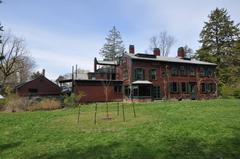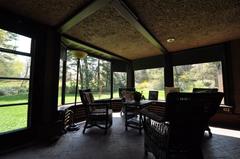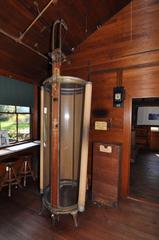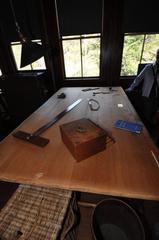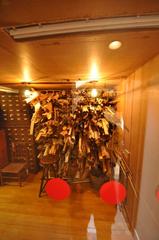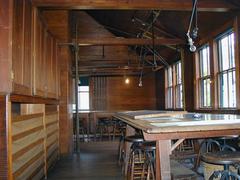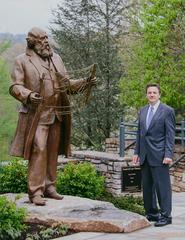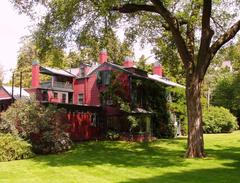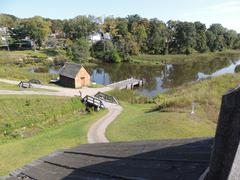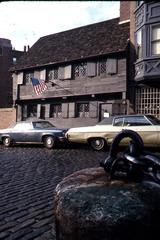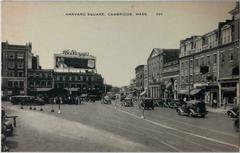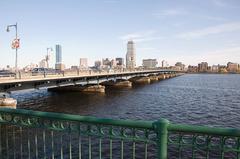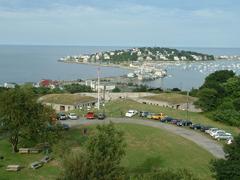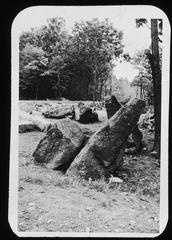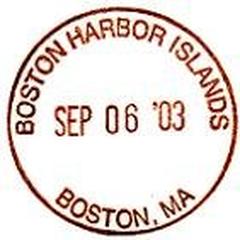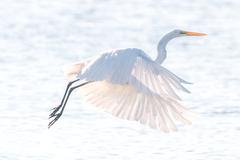
Visiting Frederick Law Olmsted National Historic Site: Hours, Tickets, and Tips
Date: 01/08/2024
Introduction
Discover the rich legacy of Frederick Law Olmsted, the pioneering figure of American landscape architecture, at the Frederick Law Olmsted National Historic Site in Brookline, Massachusetts. This site, affectionately known as Fairsted, offers a unique glimpse into Olmsted’s life, his groundbreaking contributions to landscape design, and the principles that continue to influence urban planning today. Established in 1979 under Public Law 96-87, the site preserves Olmsted’s home and office, which served as the world’s first full-scale professional office for landscape architecture (Olmsted Network, NPS). Visitors can explore the meticulously restored landscape and the original design office, where Olmsted and his successors conceptualized some of America’s most iconic parks and public spaces, including New York’s Central Park and Boston’s Emerald Necklace (Wikipedia, NPS). This guide will provide comprehensive details on the site’s history, visiting hours, ticket information, and tips to enhance your visit, ensuring a memorable and enlightening experience at this historic landmark.
Table of Contents
- [Introduction](#introductionintroduction)
- [History of Frederick Law Olmsted National Historic Site](#history-of-frederick-law-olmsted-national-historic-sitehistory-of-frederick-law-olmsted-national-historic-site)
- [Early Life and Influences](#early-life-and-influencesearly-life-and-influences)
- [Career Beginnings](#career-beginningscareer-beginnings)
- [Establishment of the First Landscape Architecture Office](#establishment-of-the-first-landscape-architecture-officeestablishment-of-the-first-landscape-architecture-office)
- [Notable Projects and Contributions](#notable-projects-and-contributionsnotable-projects-and-contributions)
- [Design Principles](#design-principlesdesign-principles)
- [Legacy and Preservation](#legacy-and-preservationlegacy-and-preservation)
- [Bicentennial Celebrations](#bicentennial-celebrationsbicentennial-celebrations)
- [Archival Collections](#archival-collectionsarchival-collections)
- [Continuing Influence](#continuing-influencecontinuing-influence)
- [Visitor Information](#visitor-informationvisitor-information)
- [Visiting Hours and Tickets](#visiting-hours-and-ticketsvisiting-hours-and-tickets)
- [Travel Tips and Accessibility](#travel-tips-and-accessibilitytravel-tips-and-accessibility)
- [Nearby Attractions](#nearby-attractionsnearby-attractions)
- [Special Events and Guided Tours](#special-events-and-guided-toursspecial-events-and-guided-tours)
- [Visuals and Media](#visuals-and-mediavisuals-and-media)
- [Photographic Spots](#photographic-spotsphotographic-spots)
- [FAQ](#faqfaq)
- [Conclusion](#conclusionconclusion)
- [References](#referencesreferences)
History of Frederick Law Olmsted National Historic Site
Early Life and Influences
Frederick Law Olmsted, born on April 26, 1822, in Hartford, Connecticut, is widely recognized as the founder of American landscape architecture. His early life was significantly influenced by his father, who had a profound appreciation for natural scenery. Olmsted’s father often took him on tours through the Connecticut Valley, White Mountains, Hudson River, and other picturesque locations, fostering a deep respect and enjoyment of natural landscapes in young Frederick (NPS).
Career Beginnings
Olmsted’s career in landscape architecture began relatively late. Before fully committing to this field, he worked in various roles, including as an administrator for New York’s Central Park, the U.S. Sanitary Commission, and the Mariposa Mining Company in California. It wasn’t until 1865, at the age of 43, that Olmsted decided to devote himself entirely to landscape architecture (NPS).
Establishment of the First Landscape Architecture Office
In 1883, Olmsted moved to suburban Boston and established the world’s first full-scale professional office for landscape design in Brookline, Massachusetts. This office, known as Fairsted, became the epicenter of American landscape architecture. Over the next century, Olmsted’s sons and successors continued to perpetuate his design ideals and philosophy, making significant contributions to the field (NPS).
Notable Projects and Contributions
Olmsted’s work is characterized by his commitment to creating public spaces that promote both physical and mental well-being. His notable projects include the design of Central Park in New York City, the Biltmore Estate in North Carolina, and the World’s Columbian Exposition in Chicago. In Boston, his work on the Emerald Necklace, a seven-mile stretch of interconnected parks, remains a testament to his vision of urban green spaces (NPS).
Design Principles
Olmsted’s design principles were rooted in sustainability and environmental conservation. He believed in creating designs that allowed for long-term maintenance and ecological health. His approach was comprehensive, aiming to have a healthful influence beyond the boundaries of the designed space. He emphasized the importance of connecting public grounds through greenways and boulevards to maximize park spaces (NPS).
Legacy and Preservation
The Frederick Law Olmsted National Historic Site, located at 99 Warren Street in Brookline, Massachusetts, serves as a preservation of Olmsted’s legacy. The site includes the restored landscape and the original office where Olmsted and his successors worked. The National Park Service manages the site, ensuring that Olmsted’s contributions to landscape architecture are remembered and celebrated (NPS).
Bicentennial Celebrations
In 2022, the bicentennial of Frederick Law Olmsted’s birth was celebrated with various events across the country. The Frederick Law Olmsted National Historic Site, in partnership with the Emerald Necklace Conservancy, created “Olmsted Now,” an inclusive coalition that connected communities and organizations to commemorate Olmsted’s contributions. This celebration was part of a larger, nationwide commemoration known as Olmsted200, hosted by the Olmsted Network (NPS).
Archival Collections
The Frederick Law Olmsted National Historic Site houses an extensive archival collection, including 66,000 photographs and 140,000 plans and drawings. These archives provide invaluable insights into Olmsted’s work and the evolution of landscape architecture. Researchers can access these materials by appointment, offering a deeper understanding of Olmsted’s design principles and projects (NPS).
Continuing Influence
Olmsted’s influence extends beyond his lifetime, with his design principles continuing to shape modern landscape architecture. His emphasis on sustainability, public health, and the integration of natural scenery into urban environments remains relevant today. The Frederick Law Olmsted National Historic Site serves as a living testament to his enduring legacy, inspiring future generations of landscape architects (NPS).
Visitor Information
Visiting Hours and Tickets
The Frederick Law Olmsted National Historic Site is open to the public year-round, with specific visiting hours varying by season. Admission is free, but guided tours and special programs may require a reservation. Be sure to check the official website for the most current visiting hours and ticket information.
Travel Tips and Accessibility
The site is easily accessible by public transportation and offers on-site parking for visitors. The historic office and surrounding landscape are designed to be accessible to all, with paved pathways and ramps available. Visitors are encouraged to wear comfortable walking shoes and bring water, as the site includes outdoor areas (NPS).
Nearby Attractions
While visiting the Frederick Law Olmsted National Historic Site, consider exploring nearby attractions in Boston. The Emerald Necklace parks, designed by Olmsted himself, offer scenic walking trails and recreational opportunities. Additionally, Boston’s rich historical sites, including the Freedom Trail and Boston Common, provide a deeper dive into American history.
Special Events and Guided Tours
The site offers a variety of special events and guided tours throughout the year. These programs provide unique insights into Olmsted’s work and his impact on landscape architecture. Check the site’s event calendar for upcoming events and tour schedules.
Visuals and Media
Photographic Spots
The Frederick Law Olmsted National Historic Site offers numerous picturesque spots ideal for photography. Capture the beauty of the restored landscape, historic office, and surrounding natural scenery. Share your photos on social media using the hashtag #OlmstedNHS to connect with other visitors.
FAQ
Q: What are the visiting hours for the Frederick Law Olmsted National Historic Site?
A: Visiting hours vary by season. Check the official website for the most current information.
Q: Is there an admission fee?
A: Admission is free, but some guided tours and special programs may require a reservation.
Q: Are there guided tours available?
A: Yes, the site offers guided tours and special events. Check the event calendar for details.
Q: Is the site accessible to visitors with disabilities?
A: Yes, the site is designed to be accessible, with paved pathways and ramps available.
Conclusion
The Frederick Law Olmsted National Historic Site in Boston is a significant landmark that preserves the legacy of one of America’s most influential landscape architects. Through its extensive archival collections, guided tours, and educational programs, the site offers a comprehensive understanding of Olmsted’s contributions to landscape architecture and urban planning. Visitors can immerse themselves in the history and beauty of Olmsted’s work, gaining a deeper appreciation for the principles that continue to shape our public spaces today (NPS).
References
- National Park Service. (n.d.). Frederick Law Olmsted National Historic Site. NPS
- National Park Service. (n.d.). Frederick Law Olmsted: History and Culture. NPS
- Olmsted Network. (n.d.). Frederick Law Olmsted National Historic Site. Olmsted Network
- Wikipedia. (n.d.). Frederick Law Olmsted National Historic Site. Wikipedia
- Boston University Today. (2012). Visiting Frederick Law Olmsted National Historic Site. BU Today
